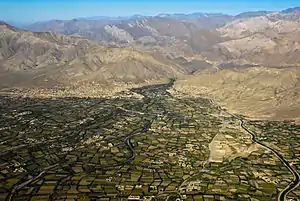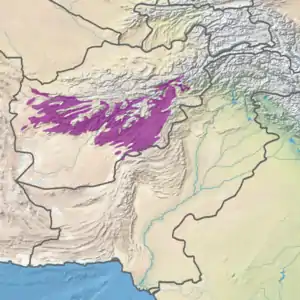Central Afghan Mountains xeric woodlands
The Central Afghan Mountains xeric woodlands ecoregion (WWF ID:PA1309) covers the xeric (dry) eastern and southern slopes of the central mountain range of Afghanistan, between the sandy desert to the south and the alpine meadows in the higher, wetter region to the north.[1][2][3] Despite the 'woodlands' in the ecoregion name, very little of the territory is forested - less than 1% - but is instead sparse vegetation or herbaceous cover.[3]
| Central Afghan Mountains xeric woodlands | |
|---|---|
 View of Charikar, Afghanistan | |
 Ecoregion territory (in purple) | |
| Ecology | |
| Realm | Palearctic |
| Biome | Deserts and xeric shrublands |
| Geography | |
| Area | 139,709 km2 (53,942 sq mi) |
| Country | Afghanistan |
| Coordinates | 32.25°N 67.75°E |
Location and description
The central mountain ranges of the Afghanistan are western extensions of the Hindu Kush mountains in the northeast of the country. These subranges center on the Koh-i-Baba (Baba Mountain Range) the Koh-e Paghman Mountains. The mean elevation is 2,058 metres (6,752 ft), with a highest peak being Kuh-e Kokzaro Zaghicha 5,125 metres (16,814 ft)[4] at the northeastern extreme of the ecoregion.[3]
Climate
The climate of the ecoregion is Humid continental climate - Hot, dry summer sub-type (Köppen climate classification Dsa), with large seasonal temperature differentials and a hot summer (at least one month averaging over 22 °C (72 °F), and mild winters. The driest month between April and September does not have more than 30 millimeters of precipitation.[5][6]
Flora and fauna
According to satellite analysis, 65% of the ecoregion is bare or sparse vegetation, and another 27% is "herbaceous cover". There are communities of Wild pistacio trees (Pistacia atlantica) at altitudes of 1,150-1,800 meters. Precipitation at these altitudes averages 250-400 mm/year. Higher, at 2,000-2,800 meters, Almond trees of genus Prunus mark a transition zone to the higher sub-alpine vegetation.[7]
Of conservation interest in the ecoregion is the critically endangered Paghman mountain salamandar (Afghanodon mustersi). A large saline lake, Ab-i-Istada in the ecoregion, is an important migratory stop in the Spring for waterfowl traveling between Siberia and the Ganges Plain of India. The site has a significant breeding population of American flamingos (Phoenicopterus ruber).[8]
Protected areas
There are no protected areas in this ecoregion.[3]
References
- "Central Afghan Mountains xeric woodlands". World Wildlife Federation. Retrieved March 21, 2020.
- "Map of Ecoregions 2017". Resolve, using WWF data. Retrieved September 14, 2019.
- "Central Afghan Mountains xeric woodlands". Digital Observatory for Protected Areas. Retrieved August 1, 2020.
- "Kuh-e Kokzaro Zaghicha". Peakbagger. Retrieved October 17, 2020.
- Kottek, M., J. Grieser, C. Beck, B. Rudolf, and F. Rubel, 2006. "World Map of Koppen-Geiger Climate Classification Updated" (PDF). Gebrüder Borntraeger 2006. Retrieved September 14, 2019.CS1 maint: multiple names: authors list (link)
- "Dataset - Koppen climate classifications". World Bank. Retrieved September 14, 2019.
- "National Biodiversity Strategy & Action Plan" (PDF). Islamic Republic of Afghanistan. Retrieved October 17, 2020.
- "Ab-i-Istada". Birdlife International. Retrieved October 17, 2020.